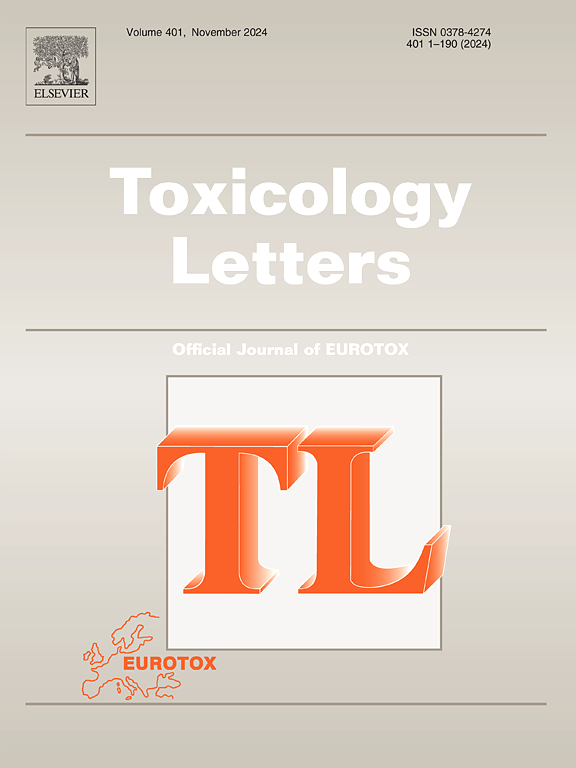Influence of high-dose sodium benzoate on lipopolysaccharide-induced neurobehavioral impairment, oxido-inflammatory brain damage, and cholinergic dysfunction in rats
IF 2.9
3区 医学
Q2 TOXICOLOGY
引用次数: 0
Abstract
Sodium benzoate (SB) is a commonly utilized food preservative in the food business. Nonetheless, apprehensions regarding its impact on the brain have garnered worldwide attention. Consequently, we examined the effect of SB on lipopolysaccharide (LPS)-induced neurotoxicity in rats. Twenty-eight male Wistar rats were randomly assigned to four groups: Group 1 (Control, distilled water), Group 2 (SB, 600 mg/kg), Group 3 (LPS, 250 μg/kg/day), and Group 4 (LPS + SB; LPS, 250 μg/kg + SB, 600 mg/kg). SB was administered orally for 14 days, whereas LPS was injected intraperitoneally for 7 days. Upon completion of the treatment, locomotor, motor, and exploratory behaviors were assessed, followed by biochemical, molecular, and histological analyses of the rat brain. Results indicated that SB exacerbated LPS-induced impairments in exploratory behavior and locomotion in rats. Furthermore, SB intensified LPS-induced oxidative stress and cholinergic impairment, as evidenced by reduced levels of superoxide dismutase (SOD), catalase (CAT), glutathione (GSH), and glutathione-S-transferase (GST) activity, alongside an increase in malondialdehyde (MDA) and acetylcholinesterase (AChE) activity in brain tissue. Similarly, exposure to SB led to a substantial elevation in the levels of pro-inflammatory cytokines, including tumor necrosis factor-α (TNF-α), interleukin-6 (IL-6), as well as nitric oxide (NO) and myeloperoxidase (MPO) activity in the rat brain. Additionally, histological examination reveals degenerative neurons in the cerebellum, cortex, and hippocampus CA1 and CA3 areas. The outcomes of this study indicate that the co-administration of SB with LPS exacerbated the neurotoxic damage caused by LPS in the rat brain.
大剂量苯甲酸钠对脂多糖诱导的大鼠神经行为损伤、氧化炎性脑损伤和胆碱能功能障碍的影响
苯甲酸钠(SB)是食品工业中常用的食品防腐剂。尽管如此,关于它对大脑影响的担忧已经引起了全世界的关注。因此,我们研究了SB对脂多糖(LPS)诱导的大鼠神经毒性的影响。雄性Wistar大鼠28只,随机分为4组:1组(对照组,蒸馏水)、2组(SB, 600mg/kg)、3组(LPS, 250μg/kg/d)、4组(LPS + SB;LPS, 250μg/kg + SB, 600mg/kg)。口服SB 14 d,腹腔注射LPS 7 d。治疗结束后,对大鼠的运动、运动和探索行为进行评估,随后对大鼠的大脑进行生化、分子和组织学分析。结果表明,SB加重了lps诱导的大鼠探索行为和运动障碍。此外,SB增强了lps诱导的氧化应激和胆碱能损伤,表现为脑组织中超氧化物歧化酶(SOD)、过氧化氢酶(CAT)、谷胱甘肽(GSH)和谷胱甘肽- s -转移酶(GST)活性降低,丙二醛(MDA)和乙酰胆碱酯酶(AChE)活性升高。同样,暴露于SB会导致大鼠大脑中促炎细胞因子水平的显著升高,包括肿瘤坏死因子-α (TNF-α)、白细胞介素-6 (IL-6)以及一氧化氮(NO)和髓过氧化物酶(MPO)活性。此外,组织学检查显示小脑、皮质和海马CA1和CA3区有退行性神经元。本研究结果表明,SB与LPS共给药可加重LPS对大鼠脑的神经毒性损伤。
本文章由计算机程序翻译,如有差异,请以英文原文为准。
求助全文
约1分钟内获得全文
求助全文
来源期刊

Toxicology letters
医学-毒理学
CiteScore
7.10
自引率
2.90%
发文量
897
审稿时长
33 days
期刊介绍:
An international journal for the rapid publication of novel reports on a range of aspects of toxicology, especially mechanisms of toxicity.
 求助内容:
求助内容: 应助结果提醒方式:
应助结果提醒方式:


